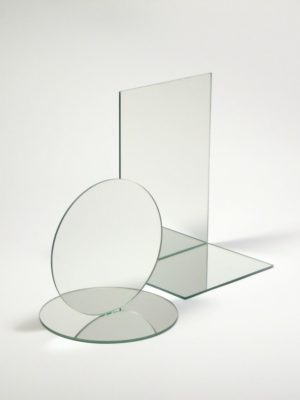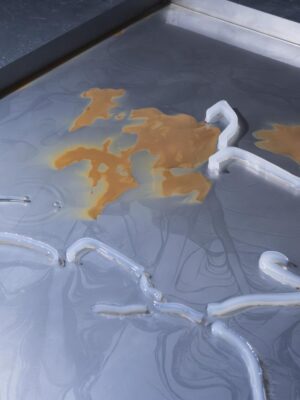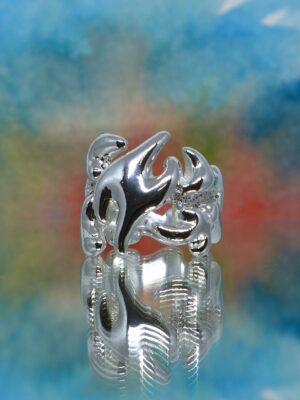Monzó’s work spans from focused and personal research, diving deep into the essence of jewellery, to expressive clay sculptures and more commercial pieces. All are presented on a level playing field, and all tell a bigger story about the artist’s oeuvre.
Rarely giving interviews, there isn’t all that much to learn about Monzó–the artist, from books or the Internet. So we, at Current Obsession, decided to take this rare opportunity and send another jeweller, Amsterdam based Benedikt Fischer, on a mission to Barcelona, to interview Marc in his studio. The conversation between two artists, framed by the city, with its stunning culture and architecture, digs deep into considerations behind the making process, Monzó’s obsessions and personal stories. We couldn’t be happier with this piece, and hope you enjoy it as much as we do!
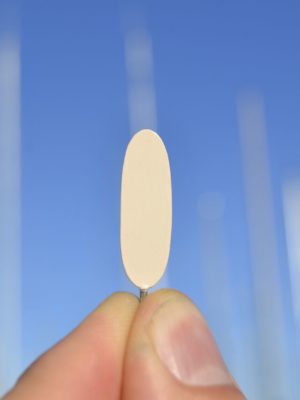
Benedikt Fischer:
Your studio has not changed since my last visit some years ago. As far as I remember you had just moved in back then.
Marc Monzó:
When I came to this workshop about three years ago, I needed a change. I wanted a very clear space and I didn’t want to have anything from the old workshop so I threw away the jewellery tables, my chairs, my drawing table – I wanted new things here. I put all the collections in boxes and created a new space, where no signs of the past were visible. It took me a month and a half to set up the space and when it was finished, I remember coming here and I was just reading, not doing jewellery for one or two weeks because I really enjoyed the fact that nothing had happened here. I knew that once I began working, the steps that I took would influence all the future steps.
Now you have to select work for the upcoming show at the Stedelijk Museum Den Bosch. Looking back on your body of work from the last 20 years, how does that feel?
It’s fine. I feel comfortable although I don’t usually like to give attention to the past, but I enjoy those first works. There is something in them that I really like so I feel comfortable showing them. Somehow the exercise of doing jewellery is like explaining how things are or how I see things so it makes sense to show a big group of work. So for me it is natural, it’s fine.
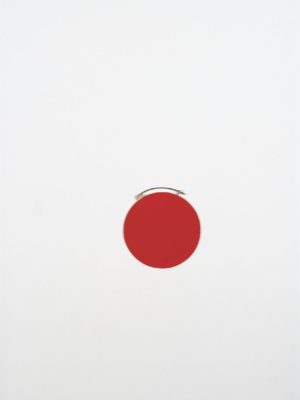
What scenography did you choose?
I wanted to organize the pieces in a specific way to explain something, so I organized it in five groups. These five groups resemble basic elements that explain a possible reality; they describe a situation in the universe where just those elements exist. It is like an idea of a reality or of a world.
It is how I see things somehow. I mean not totally like this, but it’s a synthesis of how I see things. So, of course there is Sky, which is big and open. Light and sound travel across it. It is the context where many phenomena like gravity, movement, attraction and rotation happen. It is the white paper on which all the things are placed. Then, there is House, it is related to the place where we live, it’s the space we live in. The direct environment, the structure, the identity.
Then there is Table, and Table is related to the human activity. A table represents the capacity of studying things or doing activities like drawing – it’s the human activity, trying to understand the context. The tool.
Then there is Fire, which is more of an uncontrolled situation, it includes the aspect of surprise, that you are doing an exercise, and taking some risks. It is about the balance between things, for example, doing work that involves destruction in the process. Fire is more about the possibility that changes are happening in the piece, and that not everything is under control.
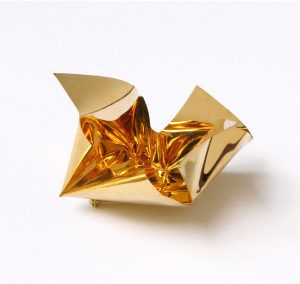
Then there is Flower. Flower, of course, means beauty, smallness and unity. One, the atomic part of something. Small elements that I did will go to this category because it is the one – ness. The single. And also verticality. This is something I am interested in: things going vertical…
So they are very basic elements but between them you can find opposites, like Flower is vertical and Table can be horizontal or Sky is big and a flower is small and in table, there is control and in Fire – there is risk. Of course, some pieces could be in two groups, the border is not always clear.
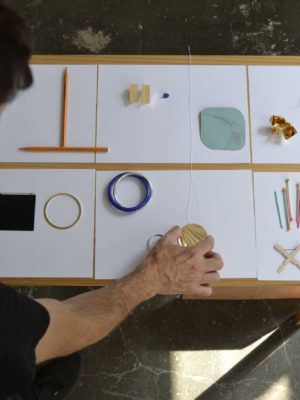
That is the fun of making collections. You could do it this way but there are always other ways to do it too.
Yes, so it is just one way to organize it. Somehow, it is like a game of studying reality. You have to find the basic elements of how things are made and try to organize them. For me, it is coming back to what you said about looking at the past and how it feels for me. It’s similar to organizing a periodic table with the work, putting them in the colour they belong in, putting things in order.
How will you show the work at the museum?
I want to keep it very clean and clear, with good lighting so that people can see what there is. I would like to use basic structures but with some lightness. One volume should represent one group because there will be objects together with jewellery. For example, showing a ceramic wall object with a small ring next to it.
It’s a nice experience to exhibit pieces that are made from very poor materials next to some that are close to ceramics and fine jewellery. Showing everything on the same level.

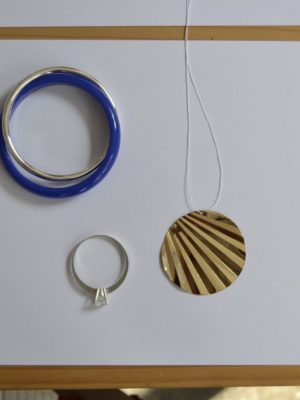
What motivates you to make objects?
It started with the wish to work together with a friend of mine, the artist David Bestué from Barcelona. One day we just thought: let’s do something. For me it was a good moment to get out of the workshop. For some reason, I was not enjoying doing jewellery that much.
We did not know what we should do and thought we should go to an unfamiliar field, where we don’t have any control. Finally, we went to a ceramic workshop located in a nice place on the countryside not too far away from the city. We went there every Friday to do ceramics for one year.
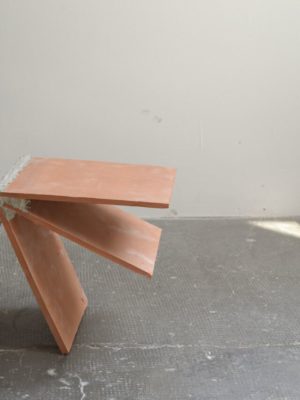
With no clear intentions, just to see what happens?
Yes, but I think from the beginning we wanted to show the outcome of this Friday activity to the public. So it was a very interesting period because we didn’t need to talk too much, we understand each other very well and we enjoy each other’s material and formal language so there was a natural dialogue. It was a lot of fun – especially because it was very unsuccessful. Everything was exploding in the oven and we did not know anything so it was a fight. Technically, the works we did are terrible but I think they illustrate that period very well and it resulted in some nice pieces.
After doing several ceramic Fridays we thought about a way to exhibit the outcome and we realized that it would be good to show other works with different materials as well. So then we did things with glass and we went to the south of Catalonia to work with alabaster and we did some objects from that material as well. In the end, there was a collection of objects and the red thread was that all of the works were really open: it was not something closed or very specific. People could define them with their own interpretation.
In the past, I also made other objects – jewels that get out of the edge of jewellery and become objects, so some of these small elements can be there too. For example, Palets de Plastic is a work that I made when I was studying. I was collecting round colourful bullets from the floor and plastic sticks that I found on the beach. They are equal elements round and equal elements linear and for me they were like magic sticks or something. I made this group and I just liked it like this, I did not want to make jewellery out of it.
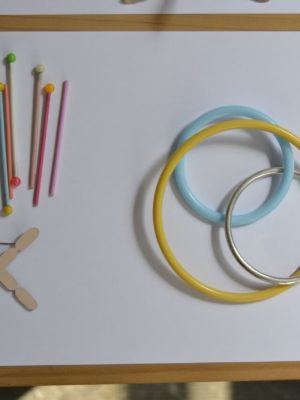
Do you usually start with the objects and draw conclusions from that and apply them to jewellery?
All my pieces come one after the other. I did the wall brooches with copper, unconscious of the fact that I did the wall with ceramic before. Only later on did I see the connection. Of course, everything is there and maybe I am not aware but I am doing an exercise that makes sense to me. So in a way, the exhibition is like a map that shows the relation between those things.
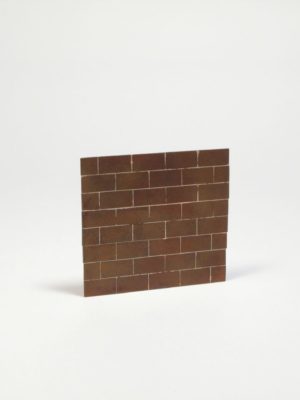
What about the clay vases, what ideas did you have there?
What I found interesting while working with this material is the fact that you don’t need tools, you just work with your hands. For the Pinch vase, the idea was to zoom into the atom dimension of things. In Catalan we say un pessic. It’s a pinch of salt that you pick up with your index finger and your thumb. Small size is something precious so for me this gesture is related to giving a sign of preciousness, of quality. It’s like taking the dimension to smallness. The small size needs attention and focus.
Another vase of this series has a round disc shape leaning onto its side. I wanted to make the size of the opening of the vase come back in the object. I thought it would be interesting to make this relation of formal elements, but there are not too many thoughts in it. There are also other vases: some are a bit more sexual.
Making objects is something that I am interested in because I understand jewellery as objects, not just as jewellery. I enjoy jewellery on the table a lot, not just on a body. There is not too much difference between object and jewellery for me, and the way that I make a piece is very similar.
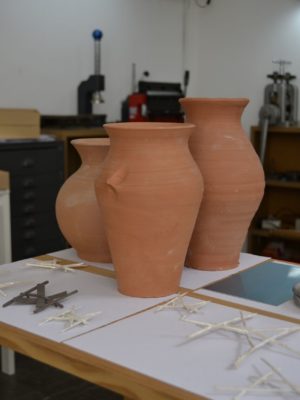

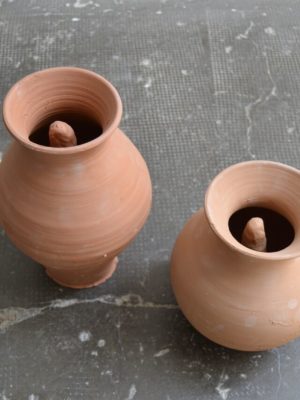
Looking at your work I was wondering about the importance of wearability. It seems to be negligible or secondary sometimes.
Yes, sometimes it is not too wearable.
Where do you draw the border between the image of a piece and the actual piece?
There are many pieces that are easy to wear in terms of size, weight and also in terms of information of the piece. They are not too conceptually charged. It is more like a formal research of material. So some of the pieces I make are very wearable and I put my attention on this aspect, in part because these works help me to live from jewellery. Periodically, it’s good for me that pieces have a clear order, that everything is in its place. Then again, it’s good to not have too much order and control. But every now and then I think it is important to work and just not think of wearability. It’s the same for techniques, sometimes it makes sense to make something rough and casted and sometimes I am very analytical and I want to file very precisely, I want two elements to fit perfectly. Other times I want things that don’t fit so I need to go from one side to the other and back again.
Because also as a human being you don’t come to the studio with the same emotions every day.
No, for me it doesn’t make sense to have one way of working, I think what makes sense is that,.. well.. I don’t know what makes sense. Haha. But things happen in different ways and it’s good that it is like that.
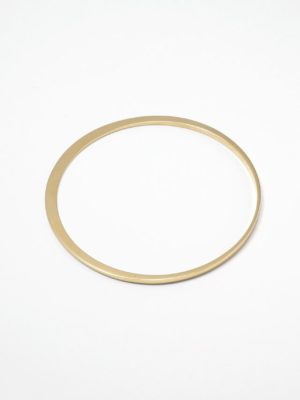
You are the creative director as well as one of the designers of a fine jewellery brand from Barcelona called Misui. Are you planning on including works from Misui in the show? When I was looking at the work, I couldn’t really see a difference from your own work.
It is very important that the project of Misui is there because for me there is not too much distinction. Of course it is a specific project but I try to keep my relation with the collections of Misui and the way I relate to material in general the same. I don’t think it should be different.
I believe the different work could live well together. I enjoy qualities of all kinds of materials. Every material can be interesting and for me it is important to show them on the same level. That’s an exciting part for me.
The only difference with Misui is that some of the materials are expensive so I cannot play with things as much. Before going into production, we have to evaluate many aspects like the prices, quantity, perception of the work and if it is a collection that includes earrings or not. Often a 3D drawing helps because you can get a little bit closer to the result.
At times we do a 3D drawing but we don’t produce the piece in 3D print because it is very important which tool to use. In the end, it does not make sense to print everything. There are some works where it really makes sense to print, or to print it partially, but then there are some works that have another dimension if you make them by hand. They are small and symbolic aspects rooted in the moment of doing them. People cannot always recognize which piece is printed and which is not, but they can feel something.
The work is made in two workshops. There is a small workshop where we produce unique pieces, orders and sometimes prototypes and then there is a big workshop close to here where everything else is produced. It’s a modern, high standard workshop where they make works for Tiffany’s so we are lucky that they wanted to produce the works of Misui as well.
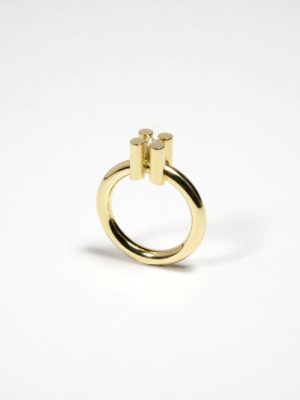
Has this way of working influenced your own work too? When I looked at your body of work, I thought that it became barer recently, closer to the essence of things. There is not so much colour left, and the playfulness is gone to some degree.
Yes. What is left is the colour of the material. It is something that changed. Some pieces are closer to shapes of traditional jewellery now.
There is a piece I made that is called Eclipse bracelet and it’s a bracelet that could be in any jewellery shop, but within that I recognize my own hand. It is the structure of a solitaire. I have a ring that is called Incomplete Solitaire, which is like the eclipse bracelet in small so there is a connection to tradition but there is also the connection to something that reappears in my work: the dialogue between the horizontal and the vertical. For me, this piece is very related to the Mirrors, for example because in the Mirrors you have two equal elements, one flat and one vertical. Both have the same size, and the idea is that it has the same horizontal and the same vertical length. It is this interdependence between horizontal and vertical proportions, even though it stems from a traditional jewellery exercise.
There is a fine edge where things are either one way or the other, once one works very close to the mass market. I really like jewellers that can operate on that border. Only very few people can make a ring from gold and a pearl and there is some little detail telling you that this is another thing. Working with the same material, same tools, and same proportions as traditional jewellery you are really on that edge.
I think in Misui it’s a bit about that. It’s about fine-tuning. I like getting close to that. Well, I like it because I like jewellery, classic jewellery.
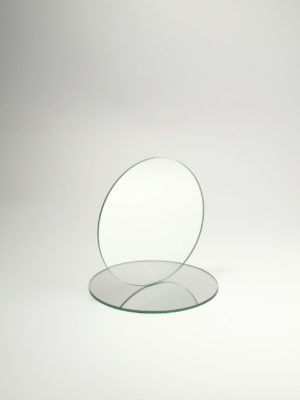
There is this term benchmark: a certain piece that is so good that you measure all the pieces that come after it by its qualities. Is there such a work within your own oeuvre?
For me, the half ring is an important piece because there was no jewellery making background for mw – there was nothing in the past. There are some qualities in them that I really like and I appreciate the freedom that I had at that moment, to just be at the beginning.
I find it very difficult to be happy with earrings but I think that the 1 Point Earrings, the flat disc that is attached to the stick on the edge, is a benchmark piece because I check any of the earrings I do with their standard. I like those earrings and I try to be as content with the new piece as I am with them.
So that work is an indicator that I use to judge my other work with, as well as the flat brooch with the locker on top – that piece is looking at the other pieces too.
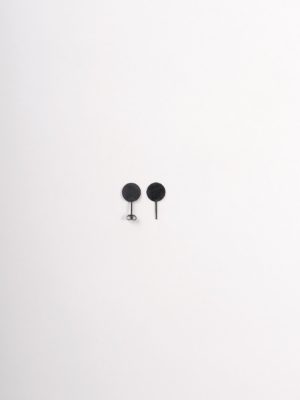
You must have produced quite a lot of them, are you not getting tired of producing certain pieces?
It is a good exercise to produce, I like production a lot. Some days it goes very well for my mind to just sit and produce, without too much thinking and analysing. Some days, I am not very playful with objects so I just sit here and I am a jeweller and I do an order, which is perfect. There is also the aspect of living from it, of earning something from my practice and I think this is important: it makes me happy. For me it makes sense to be here and to try to produce a piece and do the best I can and then offer the result to a person.
Much of your work is very affordable. Was it always something that you found important, having affordable prices?
It was like that from the beginning. During my studies, I was selling some pieces in fashion shops. The one point earrings and pieces like that. I think this aspect started by showing my work in this context from the very beginning of my career.
It’s a different way of thinking.
It’s also a different reality of a country. I probably would do different works if I studied at the Rietveld Academy in Amsterdam and showed in the galleries of Holland from the beginning.
What does it mean for you to be seen?
I still have not thought about it so much but for me it’s good to share my work because it is something that I enjoy a lot. I am very grateful, because it has been a surprise to dedicate my life, my activity to jewellery and I never expected that it would make me happy like this.
I like to see work from other people, especially from the Netherlands. I remember when I was studying, there was no Internet and one day I traveled to the Netherlands, went to see Galerie Louise Smit and to Galerie Ra. I saw all these people being independent and building their own reality with their own work. I thought it was fantastic so I feel happy now to exhibit in Holland. Maybe it sounds very beautiful but really it is how it is. It is very simple. Some days, I am in the workshop and I am very happy that I am just deciding if this should be one millimeter more or less– these are my problems. I think you are so lucky to be able to put your attention there. And of course professionally, it’s a very nice opportunity.
Speaking about travels, I read in an older interview with you that you spent some of your childhood in Africa. How did that happen?
When my brother and I were very young kids our parents were traveling to Africa a lot. My father even had a house in Burkina Faso. These are some of the first travels we did. I have very nice memories from those travels. It was what it was, there were no tricks, everything was clear and it was very good. It was not strange for me to be there.
Sometimes my brother and my father returned to Spain and I stayed there with my mother, being there with her was the best. Whenever we had to return I had a big crisis, and I cried a lot.
Unconsciously, these travels influenced me a lot. It had a big impact on me to come to realize at this young age that other ways of living are possible, that not only the reality of Barcelona exists.
I think the decision to go study at La Massana was influenced by this experience of seeing that you can live in different ways.
When I was studying, a lot was happening in my life, so finding jewellery was really important for me. At some point jewellery saved me. It was something that gave me structure, an axis of my life that I was holding on to. During those years jewellery became a refuge, something that I could control. Things have changed and now I have a different relationship to it. The practice of doing jewellery brought me good things. And so I feel at home doing jewellery.

OBSESSED! Jewellery in the Netherlands is a festival that unites the best events focussing on jewellery – exhibitions, symposia, fairs, book presentations and open studios – into one intriguing programme, put together by Current Obsession.
OBSESSED! runs throughout the whole month of November’17, in various cities across the Netherlands, accompanied by a special free edition of Current Obsession Paper and an interactive webpage.
Studio images by Benedikt Fischer
Images of the work by Marc Monzó
Fire House Sky Table Flower by Marc Monzó
18-11-2017 until 4-3-2018
Stedelijk Museum ‘s-Hertogenbosch
De Mortel 4, 5211 HV, ‘s-Hertogenbosch
Museum closed on 25 December, 1 January, 25 April and during Carnaval
Opening hours Tue-Sun 11:00-17:00
